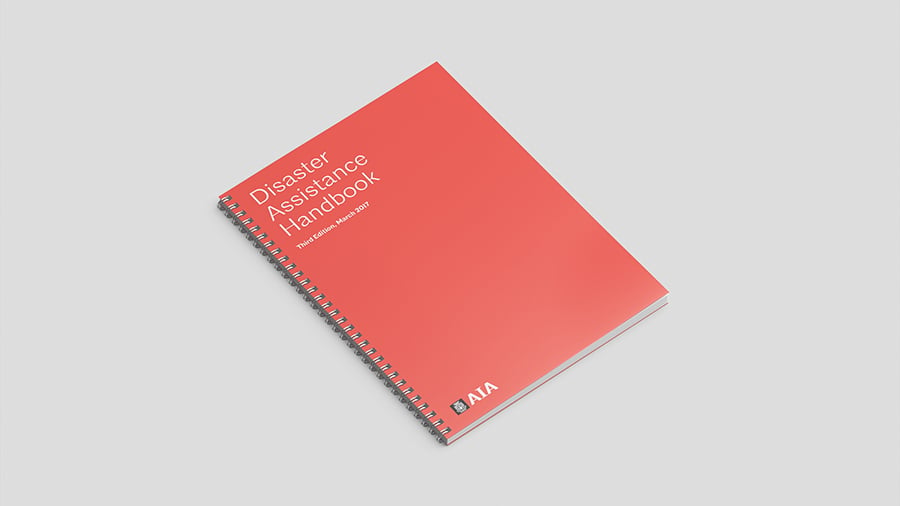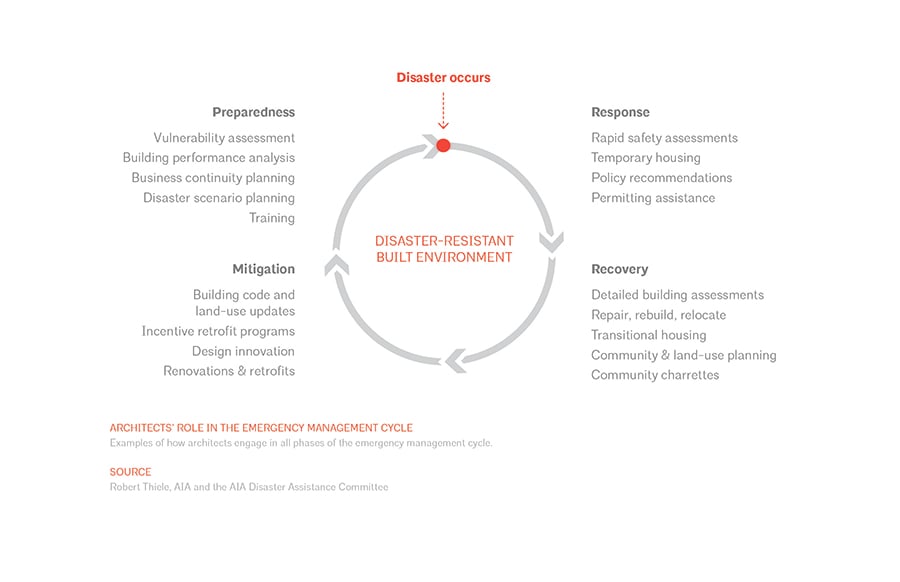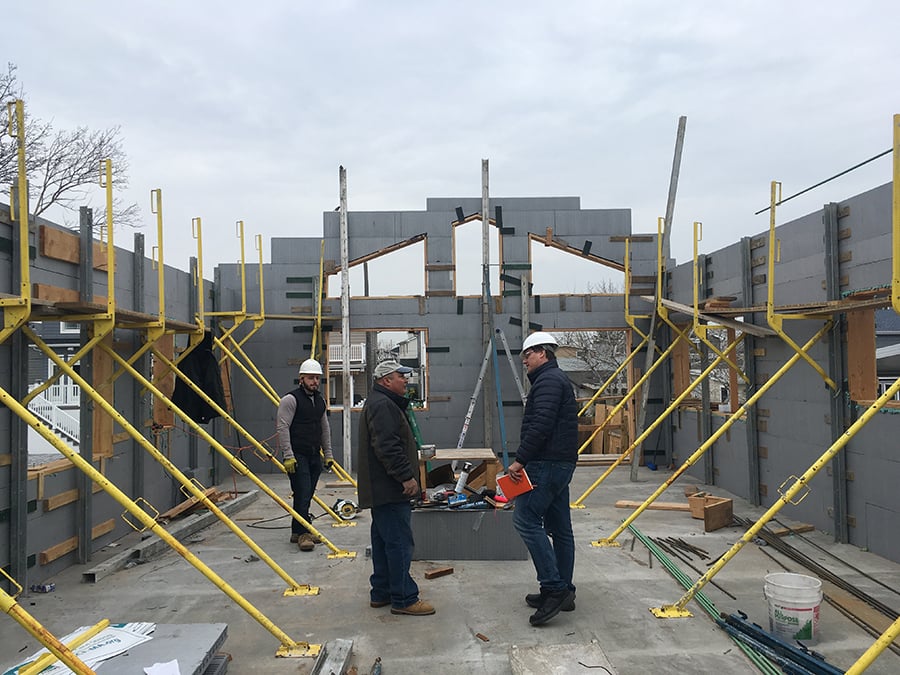
July 12, 2017
Behind the Book: The AIA’s 2017 Disaster Relief Handbook
We speak with resilience expert Illya Azaroff to understand why it took the AIA almost a decade to update this vital resource—and why it’s better than ever.
After Hurricane Katrina, the American Institute of Architects (AIA), recognizing the need for more resources and advocacy for building resilient architecture, established the Disaster Assistance Program, which supports architects who assist communities preparing for and recovering from disaster. The program published the AIA Disaster Relief Handbook (3rd edition) in March 2017.
To discuss the handbook, and resilient building in general, Metropolis contributor Hinali Shah spoke with Illya Azaroff, AIA, the founder of +LAB in Brooklyn, an associate professor at New York City College of Technology (CUNY), and a recognized expert in disaster mitigation and resilient building strategies. He worked with the regional catastrophic planning team before Super Storm Sandy and continues as an advisor to the Office of Emergency Management, Department of City Planning for the city of New York. Ilya also serves on the AIA National Strategic Council ORR Office of Recovery and Resilience.
Hinali Shah: How did you get into the field of disaster relief and resiliency?
Illya Azaroff: My father was a war refugee who grew up in forced labor camps. All the hardships that he experienced was part of my upbringing, so thinking about people who are displaced, whether from natural or manmade disasters, was part of what I learned very young.
I also grew up in Tornado Alley, so I saw a lot of disasters growing up, from time to time, and the process of rebuilding. So when I decided to go into architecture, I didn’t particularly think about disasters, but it’s something that I’ve always researched. Now that I am an architect, when I have an opportunity to teach at a university, I often engage in topics around resilience. I’ve been doing that for about 15 years, before Hurricane Sandy hit the Northeast, and I was doing a lot of work prototyping disaster relief shelters, researching materials, and those sorts of things, and trying to build in resilience into my own projects.
Since Hurricane Sandy, because I had that background in disaster and disaster assistance, then everything changed. More people needed me to assist them in ways they didn’t think about before.
HS: Did your education prepare you for that?
IA: Well, you know, the education of an architect is based on health, safety, and welfare, and resilience is based on health, safety, and welfare. So every architect actually has training, as they go through school, in health, safety, and welfare, but what’s not taught is how to recognize what you need to do to address resilience. The main difference between sustainability and resilience is if a sustainable measure fails, life does not hang in peril, but with resilience, if a disaster, a disturbance hits, you’re in trouble, and life hangs in the balance.

Courtesy American Institute of Architects
HS: How did you get involved with the AIA Disaster Relief Handbook?
IA: The AIA National, and the disaster assistance committee, saw the work that I was doing with other AIA members and asked if they could use our materials as part of the book. They created a network of all of us that are working in resilience and assembled the best practices into one handbook for quick reference.
HS: The last edition was in 2012. Why did the AIA update this handbook now?
IA: Since 2008 there have been some major disturbances in the US, and I’d like to think it’s a wake-up call. From 2005 on, we’ve had Katrina and Superstorm Sandy, to name two of the larger events. There are many, many others. But those two events really woke up the American public, but also the profession of architecture, on why resilience is really important.
The other thing is, since those two major disturbances, new legislation, new ways of building, and building science have all moved forward very quickly. You have hundreds of AIA members, like myself, working in changing the building codes, governance. That has been a big transformation.
If you look at the two handbooks, the 2008 book is good, but this one is so much better, and has so much more information, new information, and links to federal government support, not-for-profit support, all of these things that didn’t exist in 2008. It’s necessary to have that updated information if you’re going to be successful in working in resilience.
HS: Why didn’t it come out earlier, when Sandy happened?
IA: You know, that’s a good question. I think that within the AIA National structure, there really wasn’t a lot of staff dedicated to the efforts of resilience, specifically. Resilience was wrapped up as a very small piece of sustainability. There wasn’t enough support to put together this handbook until the last two years, when Rachel Minnery and Lindsay Brugger were hired at AIA. Before that it was only the disaster systems committee, which was all volunteer members. That is still in existence, and works with the two staff members now.
At the AIA, we have worked long and hard to make this one of our four pillars, to recognize resilience as one of the key issues of the 21st century. I think the devoting of staff time and funding to push resilience forward— that’s the major change.

HS: Are you working on any current projects related to this field?
IA: Yes. We’re working on lots of replacement housing, again from Superstorm Sandy. One is with the Federal Alliance of Safe Homes, and the house is a demonstration house called Hurricane Strong. So if you go on to FLASH.org, it’s the Federal Alliance of Safe Homes, there’s a live feed of this house being built, day by day.
This house is being built beyond code, and it will be built to the FORTIFIED standard, which is from the insurance industry. We’re incorporating all these resilient measures, as well as sustainable measures. The city and federal governments are watching this house. We want to show we can build better buildings at very little cost difference—and save the homeowner money on operation costs. All the electricity, heating and cooling will be less. The insurance rate will be greatly reduced upto 45%, to my understanding.
Recent Viewpoints
Viewpoints
Sustainability News Updates for Q2 2025





